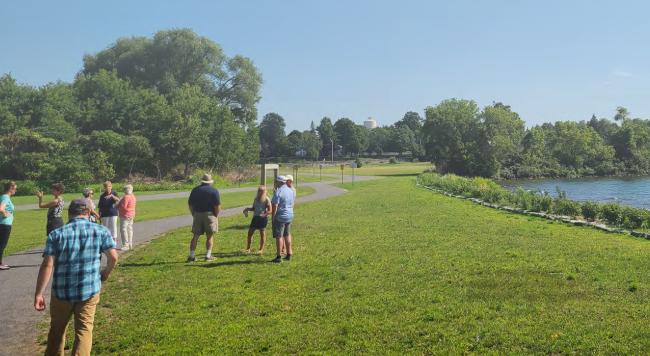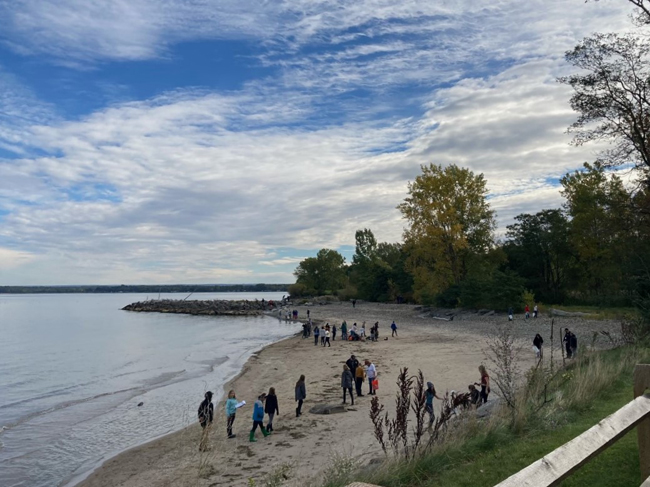NYSDEC Releases 2020-2022 Report on Restoring and Enhancing the Health of New York's Great Lakes
Highlights Efforts to Build Community Resilience to Flooding, Restore and Connect Healthy Ecosystems, Promote Environmental Justice, and Educate the Next Generation
Contacts:
Nance Arquiett, E: nance.arquiett@dec.ny.gov, P: (315) 229-2233
Watertown Headquarters, E: Information.R6@dec.ny.gov, P: (315) 785-2239
Ithaca, NY, January 20, 2023 - New York State Department of Environmental Conservation (DEC) Commissioner Basil Seggos today released the 2020-2022 Great Lakes Program Report (pdf) that highlights collaborative efforts to conserve, restore, protect, and enhance New York's Great Lakes land and water resources.
The report is prepared every two years and highlights partnerships and achievements completed during the prior two years that support New York’s Great Lakes Action Agenda (GLAA), including improving shoreline and tributary resilience, restoring and connecting aquatic habitats, educating the next generation of environmentally literate, stewardship-minded citizens and environmental professionals, and building capacity in communities that have been disproportionately impacted by environmental pollution, also known as Environmental Justice communities.
"The Great Lakes are an invaluable source of inspiration, beauty, and recreation, critical to the health and well-being of communities along their shores," Commissioner Seggos said. "This report details the impact of New York’s Great Lakes Action Agenda and efforts underway by DEC and our many partners to collaborate and protect the shared natural resources in our state and throughout the region."
The 2020-2022 Great Lakes Program Report (pdf) highlights a number of GLAA efforts and details how DEC and its partners, including New York Sea Grant (NYSG), are restoring environmental quality, conserving natural resources, promoting resilient communities, and supporting sustainable development.
Some topics where the DEC-NYSG partnership are highlighted in the 24-page report (on page 18-19) are Great Lakes coastal resiliency, literacy and stewardship capacity.

A tour of the shoreline management at Fort De La presentation held in Summer 2022. Credit: NYSDEC
Examples of Coastal Resiliency:
(a) A new factsheet, titled “Seiche Events on Lake Erie” helps shoreline property owners prepare for and respond to seiche events and associated hazards. Seiche (pronounced “saysh”) events occur when a prolonged, standing wave oscillates through a body of water such as a lake or bay.
(b) "Working with Nature to Protect the St. Lawrence River Shoreline" workshops provided chances to learn about volunteer and funding opportunities, services available from County Planning and the Soil and Water District, and state permitting considerations.
(c) NYSG led a series of three local government workshops throughout the basin in partnership with DEC, Regional Planning, and other public/private organizations in November 2022. The “Understanding and Managing Floodplains for Healthy Watersheds and Resilient Communities” workshops intended to help municipal and tribal decision-makers reduce flood risks and improve water quality throughout the Great Lakes watershed by maintaining and enhancing healthy floodplains.

The Day in the Life Student Summit event in Mexico, NY engaged middle school students in water quality monitoring along Lake Ontario. Credit: Betsy Ukeritis/NYSDEC
Examples of Coastal Resiliency:
(a) A total of $199,801 was awarded in 2021 under New York’s Great Lakes basin small-grants program, a collaborative program of NYSG and DEC, to build capacity to engage youth in environmental education and stewardship and promote the next generation of Great Lakes stewards.
(b) NYSG launched a new web-based application in 2022 that provides access to interactive tools, including a dashboard and StoryMaps, highlighting the outcomes of past small-grant-funded projects and how these projects have implemented EBM to support GLAA goals.
(c) In the summer of 2021 and summer of 2022, DEC’s Great Lakes Program and NYSG partnered with OPRHP and other local Great Lakes Ecosystem Education Exchange (GLEEE) partners to inspire 79 teachers and educators throughout New York’s Great Lakes basin to impart a deeper understanding and appreciation for New York’s Great Lakes within their classrooms and programs. A series of 8 workshops were held throughout New York’s Great Lakes, reaching a diversity of teachers—including 14 from schools within DEC-designated potential environmental justice areas. Teachers were given free resources to take back to their classrooms, where they reach an estimated 5,575 students.
(d) Under a $150,000 GLRI grant from the USEPA, DEC worked with NYSG, OPRHP, and other GLEEE partners to engage 305 middle school students in hands-on environmental monitoring and stewardship of Lake Ontario and its tributaries. Coordinated student-summit events were held at four locations throughout the watershed and a teacher workshop was held to train teachers and partners in advance of the Day in the Life student-summit event.
Other significant NYSDEC achievements in the report include:
- Investing in environmental justice and disadvantaged communities impacted by climate change and pollution by providing funding, training, and education and outreach for these underrepresented areas;
- Restoring beneficial uses, including recreation, scenic beauty, and fish and wildlife habitat for environmental justice communities in the Rochester Embayment and Buffalo River Areas of Concern;
- Demonstrating science-informed, ecosystem-based approaches for nature-based shoreline and riparian restoration that enhance resiliency and habitat, and ensure clean waterways;
- Engaging more than 300 New York State middle school students in environmental monitoring at Lake Ontario parks and tributaries through the inaugural “Day in the Life of Lake Ontario-St. Lawrence River program” supported by the U.S. Environmental Protection Agency’s (EPA) Great Lakes National Program Office; and
- Securing $40.8 million in federal Great Lakes Restoration Initiative funding for 207 projects to advance the State's initiatives and build on its commitment to restore the shorelines and waterways of New York's Great Lakes.
As guided by New York’s Great Lakes Action Agenda, DEC’s Great Lakes Program collaborates with many partners including academic and scientific institutions, nonprofit organizations, local governments, state and federal agencies and interested citizens, and promotes ecosystem-based approaches to management.
In the coming year, the Program will finalize the updated Great Lakes Action Agenda 2030, drafted with significant and diverse community input, to ensure this stakeholder-supported action plan reflects emerging challenges, science, and perspectives, and fosters innovative approaches to address the most pressing issues impacting our Great Lakes communities and ecosystems.
New York Secretary of State Robert J. Rodriguez said, “The New York Department of State continues its ongoing commitment to build resilient, vibrant, and healthy coastal communities and partner with DEC and others to empower the next generation of Great Lakes stewards. The State’s progress in turning around the health of our Lakes has demonstrated the incredible economic, recreational, and natural resource impacts they have on our communities. The progress report continues to show the way to conserve, restore and protect New York’s Great Lakes’ resources for a more sustainable and resilient future in New York’s coastal areas.”
New York State Parks Commissioner Erik Kulleseid said, “With 140 miles of shoreline along the Great Lakes, New York State Parks is proud to continue our active partnership and collaboration with state and federal partners to further restore our critical Great Lake habitats and ecosystems. New York State Parks has recently completed projects to protect and restore 58 acres of wetland habitat and 10,000 feet of natural shoreline, including 950 feet of fish passage, in the Niagara River. We continue to expand outdoor recreation and increase access for all. We look forward to continuing our collaborative work on new outdoor educational opportunities.”
DEC encourages interested individuals and organizations to get involved at the local level. To learn more and sign up for email updates, visit DEC's website, or email us at greatlakes@dec.ny.gov.
More Info: New York Sea Grant
New York Sea Grant (NYSG), a cooperative program of Cornell University
and the State University of New York (SUNY), is one of 34 university-based
programs under the National Oceanic and Atmospheric Administration’s
National Sea Grant College Program.
Since 1971, NYSG has represented a statewide network of integrated
research, education and extension services promoting coastal community
economic vitality, environmental sustainability and citizen awareness
and understanding about the State’s marine and Great Lakes resources.
Through NYSG’s efforts, the combined talents of university scientists
and extension specialists help develop and transfer science-based
information to many coastal user groups—businesses and industries,
federal, state and local government decision-makers and agency managers,
educators, the media and the interested public.
The program maintains Great Lakes offices at Cornell University, SUNY
Buffalo, SUNY Oswego and the Wayne County Cooperative Extension office
in Newark. In the State's marine waters, NYSG has offices at Stony Brook
University in Long Island, Brooklyn College and Cornell Cooperative
Extension in NYC and Kingston in the Hudson Valley.
For updates on Sea Grant activities: www.nyseagrant.org has RSS, Facebook, Twitter, Instagram, and YouTube links. NYSG offers a free e-list sign up via www.nyseagrant.org/nycoastlines for its flagship publication, NY Coastlines/Currents, which is published quarterly.